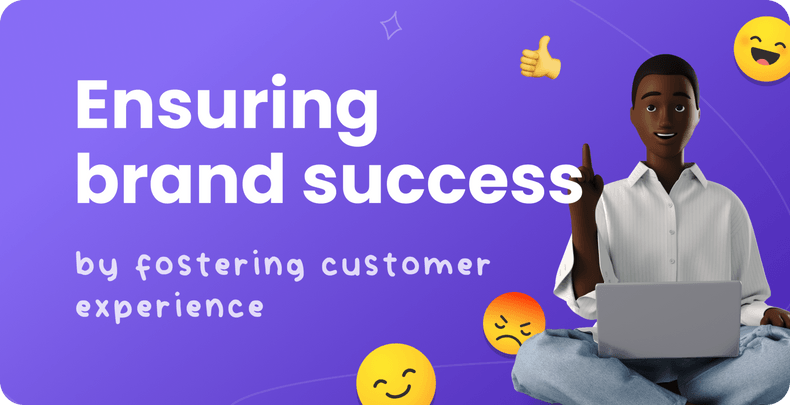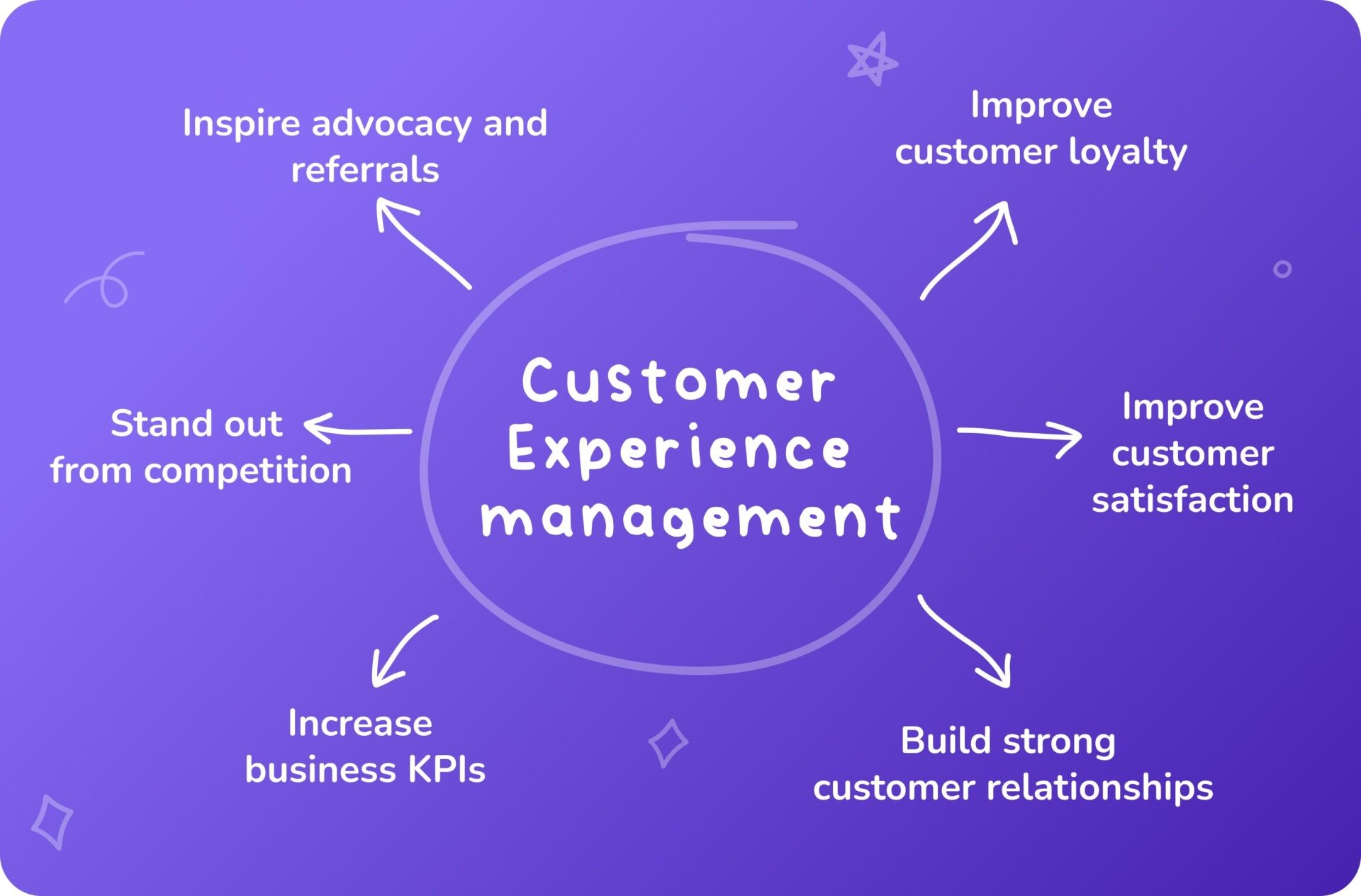Throughout this article, we’ll cover the following points:
- What is customer experience management (CXM)
- Four main components of customer experience
- Why customer experience management is important
- Positive vs. negative customer experience
- Customer experience management strategy
- Customer relationship management: how to do it effectively
- How to improve customer experience using CMX tools
- Customer feedback
Each customer experiences a brand differently, meaning that customer experience is individualistic. If a business wants to keep its customers – and have them even spend more – it should provide great customer service. 86% of people are okay with spending extra if the company makes sure they’re having a good time, but if something goes wrong, 32% will leave and never come back.
The question is: “How can a brand deliver a great experience for its customers?”
The key is getting into the core of customer experience management (or CMX), which is vital in increasing customer satisfaction rates.
By the end, you’ll be well versed in customer experience management, its importance for your business organization, and customer experience solutions and tools that ensure accurate results.
Roll up your sleeves and scroll down!
What is customer experience management?
In substance, this can be defined as a system that a business organization uses to monitor and respond to customer interactions during the buying process. This process ensures that every customer:
- Has heard about the company
- Made the first purchase
- Was assisted by the company
What is the primary goal behind customer experience management?
By relying on this tracking method, companies strive toward increasing a customer’s satisfaction score and advocacy. Also, this process is continually used to foster customer loyalty. Then Merrill, a renowned TV personality and American businessman gave us a clear view of the importance of customer experience in business today. According to his words:
Only when customer service has become habitual will a company realize its true potential
Customer experience encompasses every point of the buyer’s journey, and our job is to convey the importance behind these words to our readers.
What is the difference between customer service and customer experience?
- Is customer service the same as customer experience?
- Is customer experience contained in customer service or vice versa?
It is common to mix these two terms as they are often used interchangeably. However, it is important to note that they have different meanings. Though related, the terms are not synonymous.
Customer service is just one fraction of a puzzle, while customer experience represents the whole process. Let’s explain this in more detail.
Customer service depicts the actual human interaction between consumers and the company. This is a relatively narrow term that focuses on the assistance provided to the customer while buying a service or product. Here’s how customer service evolved over time.
Customer experience, on the other hand, depicts the entirety of the customer-brand relationship. This journey focuses on how a brand communicates with its customers. In a nutshell, customer service is viewed as a human element, while customer experience involves analyzing the data that come from customer service.
Customer experience solutions
Customer experience solutions enable companies to comprehend the impact that customer experience creates. These solutions provide understanding on a deeper and more meaningful level. The tools used gather data from customers and use them for customers. They are beneficial because they help brands bridge the gap between customer service and customer expectations.
Today’s standards require solutions. An astonishing 80% of companies believe they’re providing their clients with a superior customer experience. However, only 8% of customers would agree with this.
Four main components of customer experience
Dave Dyson, a Senior Customer Service Evangelist, explains:
“Customer experience involves every way a customer interacts with a company, at all stages of the customer journey.”
Getting into the core of customer experience, you can find that it comprises four main components:
1. Customer-focused culture
To deliver an exceptional customer experience, a company must create an environment and culture with the customer being the epicenter.
There is a fine line between employee interaction and external customers. An error that continually occurs is that a company treats its internal customers (employees) the same way as its external ones. Your internal links should be firm and exemplify accuracy, loyalty, and compassion towards outside sources. This is the base of creating a pleasant environment for external customers.
2. Service experience design
The second component is Service Experience design. In a few words, this mechanism aims at helping the business design and maintain the most favorable customer experience. Moreover, service experience design tries to answer the question of how easy it is to do business with a brand. Mind you, delivering excellent service involves taking an extensive view of the business as a whole and exploring each touch point in more detail.
3. Service experience delivery
Service experience delivery focuses on your determination as a business to provide your customers with an excellent customer experience while maintaining discipline simultaneously. If business growth is your top priority, you ought to work toward building a customer-friendly strategy and therefore ensuring a superior customer experience.
Here’s a catch: Although your customers are aware that an immediate answer is not always possible, they expect feedback promptly. Therefore, creating time scales and nurturing relationships is a must for any business to keep afloat.
4. Customer satisfaction
A satisfied customer will often tell their family and friends about their great experience, but if they had a negative one, they’re 3 times more likely to share it.
Case in point: customer satisfaction is crucial in creating a successful business. Without your customers bringing in more customers, there would be no business, so putting customer satisfaction as your number 1 priority is highly justified. Customer feedback should be valued and taken into consideration.
Why is customer experience management important?
As we approach the core of customer relationship management, it is inevitable to ask ourselves: “Why is a customer’s experience significant?”
The answer that any successful business will give you is that customers are the foundation of every business, the root. Now, more than ever, customer experience is valued because satisfied customers are the ones that help businesses outgrow the competition and maintain trustworthiness. Customer experience is the string that keeps the business alive. Without diminishing its importance, customer experience can make or break a business. Here are a few unanimous points that show why customer experience is vital for your brand’s success.
Humanizing your business
The days when running a business monotonously, by just displaying the products and expecting returns, are long gone. The age that we live in today expects businesses to connect with their customers and show their “face”. Customers are looking to interact with the business they’re purchasing products from on a more personal level. Humanizing your business, giving it a personality, and nurturing relationships with customers that are not generic is a huge plus.
Brand advocacy
More than 50% of online purchasing activities are customer-influenced.
Brand advocacy is when your individual customers, after getting an exceptional customer experience, praise your business on other social media platforms. Besides the obvious fact that this contributes to brand loyalty, it represents an effective strategy for business growth. With different internet platforms being the breeding ground for both good and bad reviews, you cannot deny the impact it has on overall customer expectations.
Employee engagement
Both sides of the customer-company relationship are important. And just as collecting customer information is vital for further business flow, your employees must be engaged. Organizations that commit to delivering a great customer experience have 1.5 times more engaged employees. This way, many organizations are bound to outshine their top competitors. It can be said that EX directly affects CX, meaning that employee experience promotes a positive customer experience.
Revenue growth
Lastly, the logical outcome of successful customer experience management is increased revenue. A customer assisted correctly and provided with exceptional service will return. Here’s a fact to back that up. Research states that satisfied customers are the backbone of a successful business. They are responsible for a 300% increase in revenue over three years.
Positive vs. negative customer experience: know the difference
Without customers, your brand would not exist. While positive reviews can boost your revenue, poor customer experience can literally bury your business. Marketing professionals should put their heart and soul into creating solutions that promote positive reactions and foster customer engagement. But knowing the positive sides is just 50%. The other 50% is familiarizing yourself with bad examples and learning to avoid the red flags. Let’s take a minute to look at positive and negative customer experience examples.
Positive experience examples
After receiving proper assistance, 72% of customers will share their experience with six or more people in their community.
Good customer experiences might look like this:
- Insightful website design
- Realistic product/service expectations
- Customer support team is available 24/7
- Self-help resources that are easily accessible
- Collecting customer feedback to understand the target audience
- Communication channels that are easy to navigate (web and mobile app integration)
- Price transparency in sales
Negative experience examples
After receiving a poor customer experience, 89% of customers will turn to your competitor.
Poor customer experiences include:
- Re-entering information multiple times
- Unresolved issues/unanswered questions from customers
- Emphasized automation
- Generic service
- Long loading time
- Unclear UI/UX
Brands that pay little to no attention to customer research and refuse to create a more enjoyable experience for their customers are likely to witness many drop-offs in their marketing campaigns.
What is customer experience management strategy?
Your goal as an organization is to sell a product or service. To do that successfully, you must be familiar with customer needs.
You need to know information about the customer before you start your pitch.
Your pitch shouldn’t be centered around surface information; you need to get into the personality traits and learn more about the people buying from you. In essence, you need to be familiarized with your target buyer group. This is just the starting point, though.
While you’re talking with new customers, a bunch of questions is going through your mind:
- Do my customers have a specific product/service in mind?
- Do we offer unique products/services?
- How can I help my customer narrow down the choice?
As you’re contemplating the answers to these questions, there’s one thing you need: a well-developed strategy. By definition, a customer experience management strategy represents the base you use to measure, optimize, and analyze customer experience. The absence of one is also the main reason for a business’s downfall. Many organizations are solely interested in gaining profit, and therefore, they completely neglect customer care.
Customer relationship management: how to do it effectively?
The stakes are high. If a customer has just one bad experience with your brand, 1 in 3 of them are likely never to come back. At first glance, managing customer experience might seem like a daunting task. However, it’s not always like that. It’s all about creating efficient strategies.
Here are the top 3 strategies that have shown positive results in improving the overall customer journey:
1. Personalization
Several surveys have shown personalization’s positive effect on customer loyalty and retention. 93% of brands have witnessed an increase in relying on personalization strategies. It’s clear as day that customers long for personalization. Why? Because they want to be understood. So, when employees devote their time to research and understanding customer needs, they work towards creating a stronger bond. Luckily, there are several ways to implement personalization and contribute to smooth customer journeys.
- Personalized survey questions based on customer experience data
- Recommendations based on previously made purchases
- Personalization based on location
2. Customer journey map
You can also adhere to using a customer journey map. This visual represents the entire interaction an individual customer has had with the brand. It helps the employee come to terms with all of the potential problems and opportunities that are a part of the customer experience. By relying on this strategy, you can cross-check:
- Churn rate
This is the percentage rate of customers who unsubscribe from a service within a given period of time. Here’s the formula:
- Retention rate
This is a measure that’s most commonly used by subscription-based businesses, companies, and brands whose customers buy the same product over and over again.
- Level of satisfaction
Customer Satisfaction Score (CSAT) is a measure used to measure customers’ satisfaction or dissatisfaction, usually on a scale 1-5. For easy and editable customer journey maps, check out these on-point templates.
3. Make use of technology
Nowadays, everything relies on technology, and we see it improve daily. Artificial Intelligence (AI), for example, can contribute significantly to creating a customized experience. You’ve probably already seen 24/7 chatbots. This functionality can help you understand customers’ needs in free-form messages. 24/7 customer support is the first-aid kit of purchasing products and services.
How to improve customer experience using CMX tools?
There are a variety of different CMX tools, and each one can be used in a slightly different way to achieve different results. In order to get the most out of CMX tools, it’s important first to understand how they work and what they can do for your business.
Then, you need to identify which tools will work best for you and your customers and start using them as often as possible. The more you use them, the more benefits you will see.
1. Split testing (A/B testing)
A/B testing, also known as split testing, is a method of comparing two versions of a web page or app to see which one performs better. You can use A/B testing to compare different designs for a landing page, different wording for a call-to-action button, or different colors for your buttons.
2. Content management
Content management provides expert insights on what your customers want to see across digital channels. After you get the results, you can continue to build relationships by focusing on that content.
3. Helpdesk tools
Another way of enhancing customer experience is working on your customer support. When a customer calls customer support, they expect their problem to be solved in a timely manner. And analyzing customer complaints can be a great way to improve service quality. Help desk tools offer support by integrating all of your channels, such as social media, phone calls, email, etc.
4. Survey and Voice of Customer platforms
Survey and Voice of Customer platforms are valuable tools for understanding customer needs.
They allow businesses to collect feedback from customers in a variety of ways, including surveys, questionnaires, and interviews. This feedback can then be used to improve products, services, and marketing efforts.
Survey and Voice of Customer platforms are becoming increasingly popular with both small businesses and large corporations. They offer a variety of features that can be customized to meet the specific needs of each business.
Customer feedback
Customer surveys are, by far, one of the top ways to measure customer satisfaction. Response rates can go up to 85%, provided that the consumers are motivated to fill them out and that they are well-crafted.
These are the main types of surveys used to measure customer sentiment:
- Customer satisfaction (CSAT) surveys
CSAT are questionnaires that let companies learn about their customer satisfaction with the products, services, support, etc. The key to a successful survey is responding to negative customer feedback in order to maintain high levels of customer satisfaction.
- Net Promoter Score (NPS) surveys
The goal of an NPS survey is to determine how likely a customer is to recommend your product or service to others. Customers are asked to respond on a scale from 0-10, with 0 being the least likely to recommend and 10 being the most likely.NPS scores can be used to track customer satisfaction over time and identify areas where you need to make changes in order to improve customer loyalty. - Customer Effort Score (CES) surveys
CES survey helps businesses assess customer satisfaction by measuring how much effort it takes to use their product or service. The survey results can help pinpoint where they need to strengthen their products and make them more customer-oriented. Such surveys can be sent through email, conducted over the phone, or completed in person. - User experience surveys
UX surveys are a valuable tool for understanding how users interact with your product. However, it’s important to make sure that you ask the right questions and that you interpret the results correctly. Otherwise, you may end up making decisions based on inaccurate information. - Product satisfaction surveys
Product satisfaction surveys are a valuable way for businesses to measure customer satisfaction with their products. By conducting regular surveys, businesses can track changes in customer satisfaction over time and identify areas where they need to make improvements. Satisfaction surveys can also help businesses determine how well their marketing and advertising efforts are working.
- Market and customer research surveys
Conducting market and customer research surveys is important for a number of reasons. The most obvious reason is that it helps businesses to understand their customers’ needs and wants. This information can then be used to create products or services that are more likely to be successful in the marketplace.Another reason why market and customer research surveys are so important is that they can help businesses to identify new markets and opportunities. By understanding which segments of the population are most likely to purchase their products or services, businesses can focus their marketing efforts on these groups, increasing their chances of success.
Wrapping up
Customer experience management (CXM) is the process of understanding customer needs and preferences to deliver a positive experience. It’s essential for businesses today because customers are more informed and have more choices than ever before. To keep up with the competition, it’s important to focus on delivering an exceptional customer experience. This can be done through various strategies such as incorporating CMX tools, relying on customer feedback, and creating a human face for your brand. By doing this, you’ll not only acquire valuable data but also increase retention and loyalty among customers.
Meta Description:To get into the core of customer experience management and see why it’s essential for your brand, take the time of day to scroll through our article!










